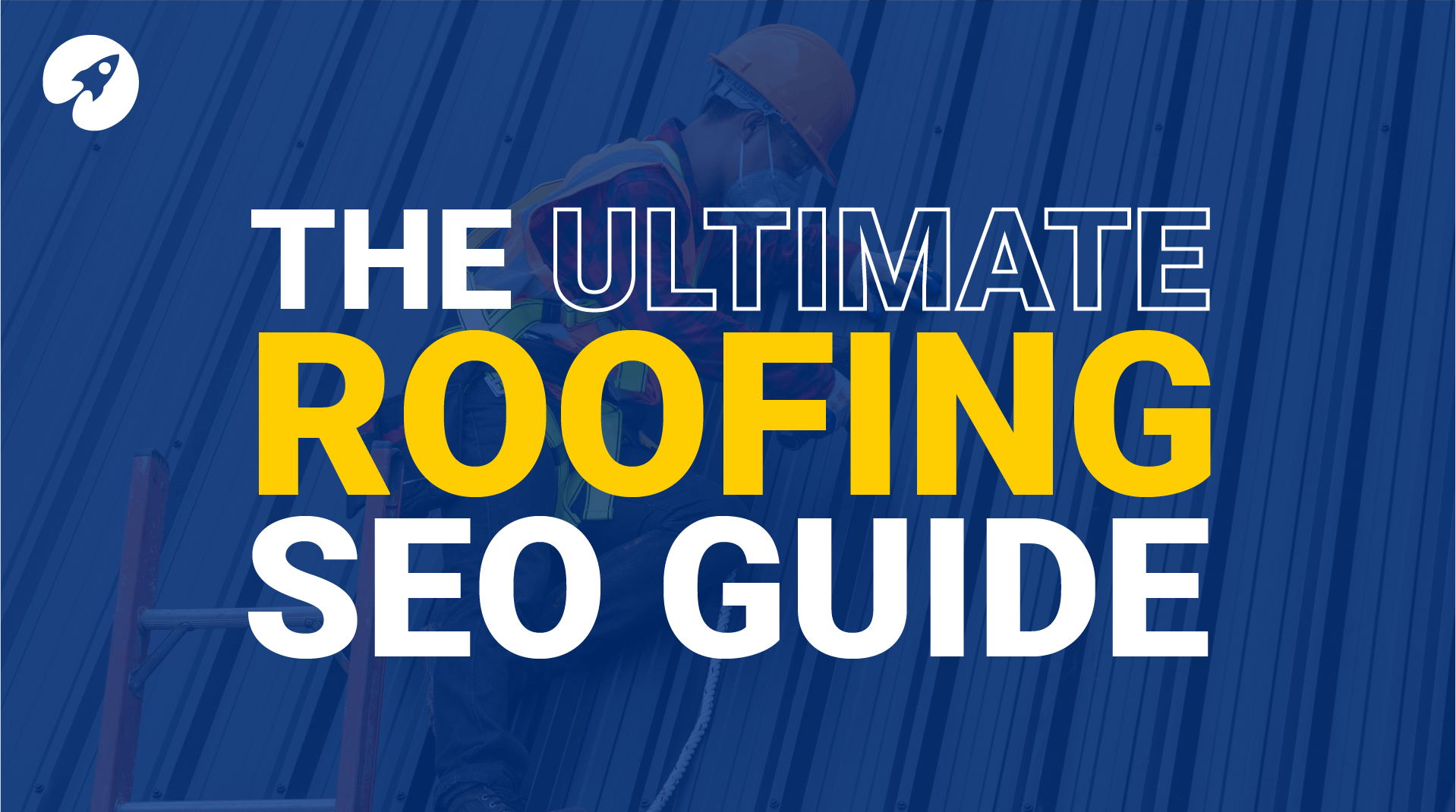
As a roofing contractor, you know that having a solid online presence is essential to attracting new customers and growing your business.
But what’s the best way to ensure your roofing website is visible to potential customers?
One of the best ways to generate more roofing leads is search engine optimisation (SEO).
SEO is the process of optimising your website so that it ranks higher in search engine results pages (SERPs), making it more likely that people will find and click on your site.
Many different factors go into SEO, but by following these simple tips, you can start to see accurate results for your roofing business:
Why is a roofing SEO strategy important for your business?
SEO raises your brand awareness.
When your website appears at the top of search engine results pages, it helps to increase your brand awareness and name recognition.
People are more likely to trust a roofing contractor that appears on the first page of Google than one that doesn’t appear until the second or third page.
SEO generates leads for your roofing business.
A strong SEO campaign will help you to generate more leads for your roofing business.
By appearing higher in search engine results, you’ll reach a wider audience of potential customers looking for roofing services in your area.
Search engine optimisation will increase your revenue.
By generating more roofing leads and increasing your brand awareness, SEO can help you to increase your revenue.
A successful SEO campaign will result in more customers finding and using your roofing services, eventually boosting sales and profits.
Local SEO and and national SEO
As a roofing contractor, you’ll want to focus on local and national SEO.
Local SEO is where your website will show keywords such as “roofing contractors in London” and national SEO is where your website will show keywords such as “what’s the cheapest way to repair a roof?”.
You can use techniques to target both SEO strategies, which we will go through in this article.
This guide will cover
- 24. Monitoring and tracking results with Search Console & Analytics
- 23. Guest posting
- 22. Focus on user experience
- 21. Have great backlinks to your roofing website
- 20. Using social media
- 19. How to find the best roofing keywords
- 19. How to write page titles and descriptions
- 18. How long should the content be on your roofing pages
- 17. How to do competition research
- 16. How to structure content
- 15. How to get listed on local directories
- 14. How to find local websites to share your content
- 13. Title tags, meta description & headers
- 12. Why you should build a blog
- 11. Alt tagging images
- 10. How long does roofing SEO take
- 9. Your URL structure
- 8. How to optimise your Google My Business listing
- 7. Mobile Optimisation
- 6. USPs & CTA
- 5. Internally linking your pages
- 4. Share all your new content on websites like Quora
- 3. How to write schema
- 2. Page speed optimisation
- 1. How to track keyword performance
24. Monitor and track results with search console and google analytics

Before we get started it is important to monitor and track the performance of all of your SEO efforts. The best way to do this is with Google Search Console and Google Analytics.
Google Search Console is a free tool that shows you how often your website appears in Google’s search results. It also shows you the average position of your website for specific keywords.
Google Analytics is a free tool that shows you how much traffic you’re getting to your website, where that traffic is coming from, and what people are doing on your website.
You can see what’s working and not by monitoring and tracking your results. This will help you fine-tune your local SEO strategy and get better results.
How to instal search console
- Go to https://search.google.com/search-console/about
- Click “Add property” in the top right corner
- Enter your website’s URL
- Click “Add”
- will be given a code to add to your website. This is how Google verifies you own the website
- Copy and paste the code into your website’s HTML
- Save your changes and close the file
- That’s! You’ve successfully installed search console on your website
How to install Google Analytics
- Go to https://analytics.google.com/analytics/web/
- Click “Sign In” in the top right corner
- Enter your Google account information
- Click “sign in”
- Click “Create Account.”
- Enter your website’s information
- Select your industry category and timezone
- Accept the terms and conditions
- Click “next step”
- Will be given a code to add to your website. This is how Google verifies you own the website
- Copy and paste the code into your website’s HTML
- Save your changes and close the file
Using Search Console to track results
23. Guest posting for roofing websites
If you’re looking for ways to get your roofing business website in front of more people, guest posting is a great option.
Guest posting involves writing and publishing articles on other websites in exchange for a link back to your website.
This is a great way to get high-quality links to your website, which can help improve your search engine rankings.
When guest posting, it’s essential to focus on quality over quantity. It’s better to publish one well-written article on a popular website than it is to publish ten poorly written articles on less popular websites.
To find guest posting opportunities, search Google for terms like “guest post” and “write for us.” You can also search for websites that accept guest posts in your industry.
Once you’ve found a few guest posting opportunities, reach out to the website owner and pitch them an article idea. If they’re interested, they’ll usually provide you with guidelines to follow when writing your article.
Still, finding organic guest post sites might be very time-consuming, especially if you have little experience. It’s even more complicated when you’re targeting competitive markets. If you want to get backlinks from the UK, US, or Europe, you can try a more tactical promotion. For many, this means outsourcing guest posting and link-building to freelancers or agencies.
22. Focus on user experience
Focus on the user experience on your website, its not all about keywords and data, your website also has to be easy to use. Your website’s user experience is important for two reasons: first, because it’s a ranking factor for Google, and second, because it directly impacts your website’s conversion rate.
There are a few things you can do to improve your website’s user experience:
- Make sure your website is mobile-friendly
- Use clear and concise copy
- Use easy-to-understand language
- Use whitespace to improve readability
- Use high-quality images
- Improve your website’s navigation
Your user needs always to be one click away from getting to where you want them to go, this could be a contact page or get a quote page, if they can not see this clearly, it will massively damage your conversion rate.
21. Have great backlinks to your website
I know we have covered this post, but we can not stress the importance of having good backlinks on your website to get traffic and rank higher for competitive keywords.
>>>> Use this tool to check your backlinks
Backlinks are links from other websites to yours. They are an important ranking factor for SEO and can help your website to rank higher in search engine results pages (SERPs).
There are a few things you can do to get high-quality backlinks:
- Publish high-quality content
- Create infographics
- Write guest posts for other websites
- Directory submissions
- Social media posts
One of the best ways to get high-quality backlinks is to publish great content that people will want to link to.
This could be anything from a blog post, infographic, or video. Once you’ve published your content, contact other websites and ask them to link to it.
If you’re unsure what content to publish, use a tool like BuzzSumo to find popular content in your niche that’s been widely shared on social media.
You can create something similar or even better and reach out to the people who shared the original piece of content, asking them to share yours.

20. Use social media
Social media is a great way to drive traffic to your website and improve your search engine rankings. Here are a few things you can do:
- Use social media buttons on your website so that people can share your content
- Post links to your content on social media platforms
- Create social media ads
- Create social media groups and communities
Social media buttons make it easy for people to share your content on their own social media platforms.
This can help to increase your reach and drive traffic back to your website.
Posting links to your content on social media is a great way to get people to click through to your website. You can also use social media ads to promote your content and drive traffic to your site.

19. How to find the best roofing keywords
Use a keyword research tool
To find the best keywords for your roofing business, you’ll need to use a keyword research tool.
Many different keyword research tools are available, but some of the most popular ones include Google Keyword Planner, SEMrush and Ahrefs.
Enter your seed keywords.
Once you’ve selected a keyword research tool, you’ll need to enter some seed keywords into the tool.
Seed keywords are simply the starting point for your keyword research. They can be general terms related to your roofing business, such as “roofing” or “roof repair”.
Identify relevant keywords.
After you’ve entered your seed keywords, the keyword research tool will generate a list of related keywords.
You’ll need to go through this list and identify the keywords that are most relevant to your roofing business.
Check the search volume.
Once you’ve identified some relevant keywords, you’ll need to check the search volume for each keyword.
The search volume is the number of people who search for a particular keyword each month.
A high search volume means that many people are searching for that keyword, while a low search volume means that few people are searching for that keyword.
Choose your keywords.
After you’ve checked the search volume for each keyword, you’ll need to choose the keywords that you want to target.
You should choose a mix of high- and low-volume keywords and short-tail and long-tail keywords.
Short-tail keywords are general, one-word keywords, such as “roofing”. Long-tail keywords are more specific, three- or four-word phrases, such as “roofing contractors in London”.
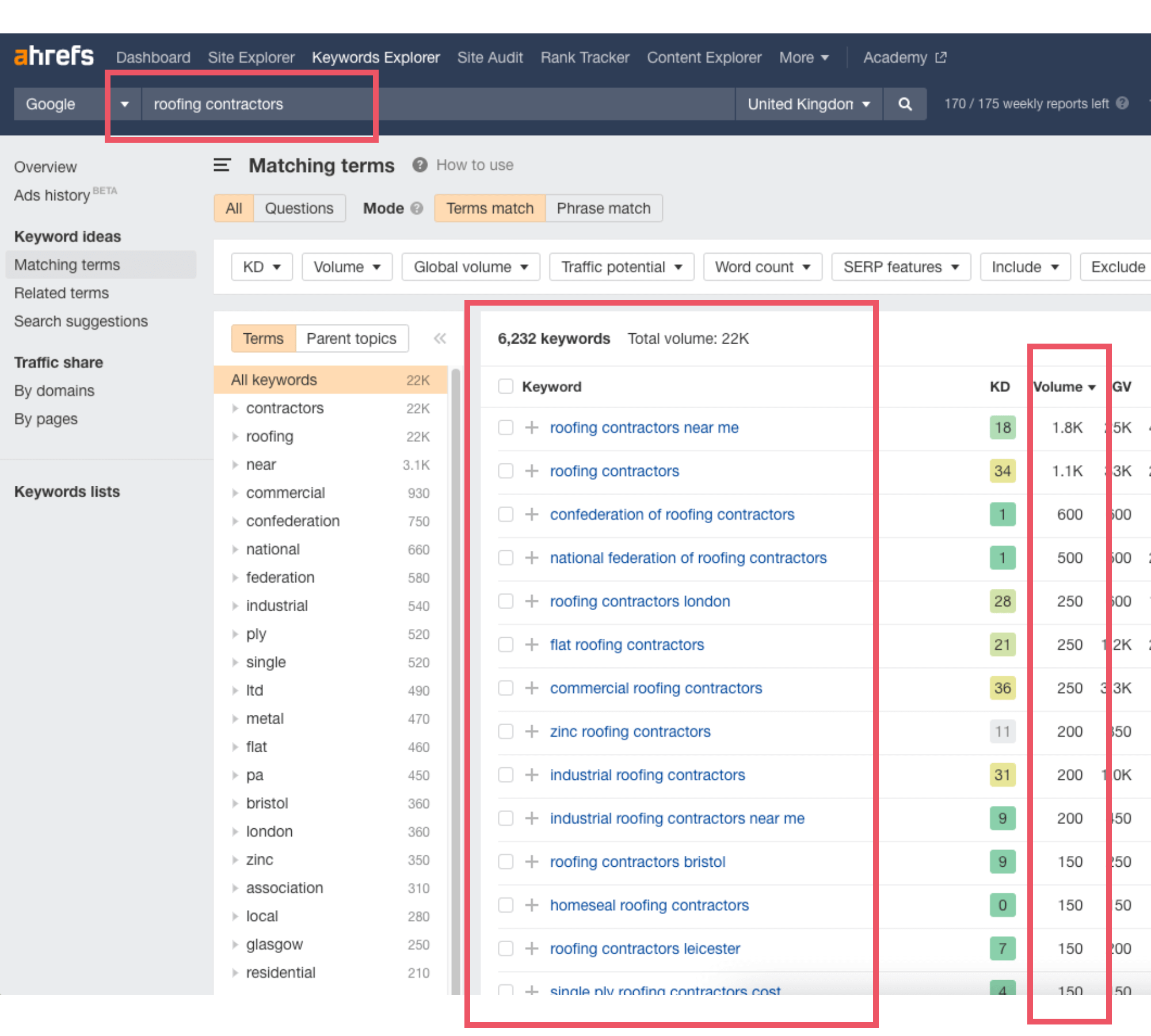
18. How long should the content be on your roofing pages?
The answer to this question depends on the keyword you are targeting. For example, if you are targeting a short-tail keyword like “roofing”, you’ll need to have a lot of content on your page to rank for that keyword.
On the other hand, if you’re targeting a long-tail keyword or local keyword like “roofing contractors in London”, you won’t need as much content because there will be less competition.
A good rule of thumb is to aim for at least 1000 words of content on each page, but more is always better. The most important thing is to ensure that your content is more relevant, well-written, and informative than the competing page already at the top of Google.
17. How to do competition research
Competition research is essential because it allows you to see what your competition is doing and how they rank. This information can be used to improve your website and help you to rank higher in the search engines.
There are a few different ways to do competition research:
Use tools like SEMRush or UberSuggest
SEMRush is a tool that allows you to see how much traffic your competitor’s website is getting, what keywords they are ranking for, and what their backlink profile looks like.
This information can be very useful in understanding what you need to do to outrank your competition.
UberSuggest is a free tool that you can use to find your competitor’s keywords, top-ranking pages and backlinks.
Simply put in your competitor’s domain, and this will show all the data. Copy all of this data onto sheets and use this on your website.
16. How to structure your roofing website
The way you structure your roofing website is essential for two reasons:
- It makes it easy for Google to understand your website and index your pages correctly.
- It makes it easy for users to navigate your website and find the information they want.
Here are a few tips for structuring your roofing website:
Use keyword-rich page titles
Your page titles should reflect the main keywords you are targeting for that page. For example, if you are selling roofing services in London, your homepage title should be “London Roofing Services – ABC Roofers”.
Use keyword-rich URLs
Your URLs should also reflect the main keywords you target for that page. For example, if you are selling roofing services in London, your URL should be “www.abc-roofers.com/london-roofing-services”.
Use keyword-rich H1 tags
Your H1 tags are the main headlines on your page and should be reflective of the main keywords you are targeting for that page. For example, if you are selling roofing services in London, then your H1 tag could be something like “London’s Top Roofing Services Provider.”
Have pages dedicated to each roofing service you offer
Having a separate page for each service is essential if you offer multiple roofing services.
This makes it easy for users to find the information they are looking for and also allows you to target different keywords for each page. For example, have pages for “roof repair” “new roofs” “roof surveys” and so on.
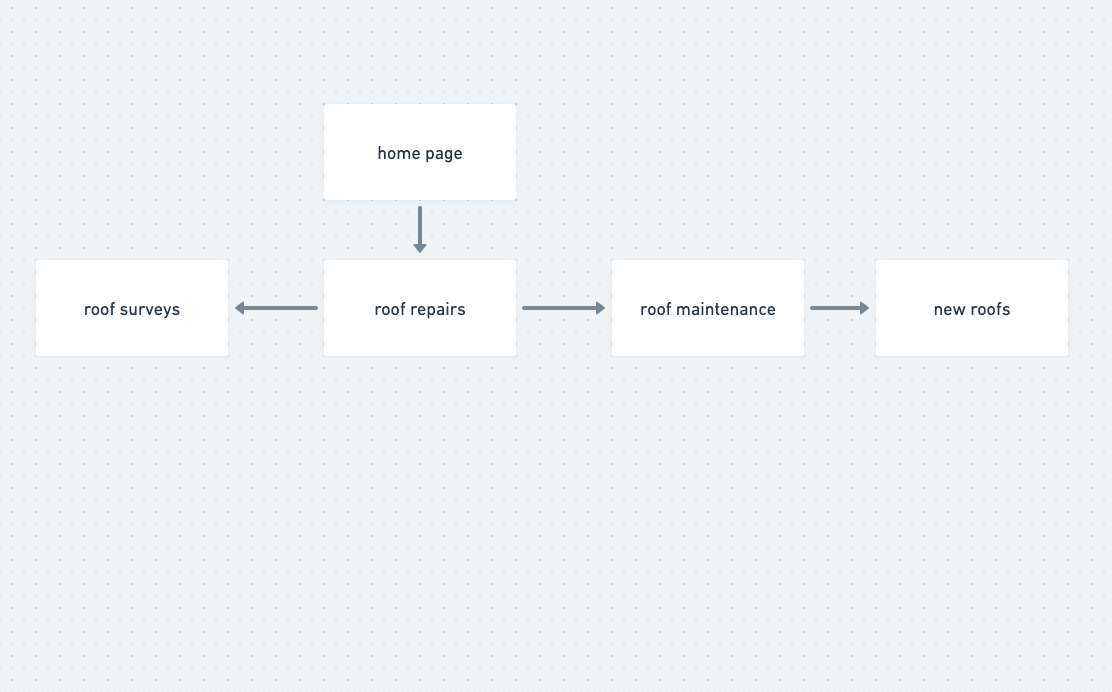
15. Get listed on all major directories.
One of the best ways to see your roofing website noticed by potential customers is to list it on all major directories.
This will help to increase your visibility and also help you to rank higher in the search engines.
Some of the best directories to list your website on are:
- Yell.com
- Checkatrade
- Trustatrader
- Thomson Local
- FindaTrade
- Rated People
- MyBuilder
To list your website on these directories, simply go to their website and create a listing. Make sure to include all your essential information, such as your business name, address, phone number, website URL, and a brief description of your services. You should also include some high-quality photos to show off your work.
Once you have created your listings, monitor them regularly and ensure that all the information is up-to-date.
You should also respond to any reviews or enquiries that you receive promptly.
14. Find local websites to share your content.
To get your roofing website seen by more people, it’s essential to share your content on local websites.
This can be done by submitting articles, press releases, or even just simple listings.
Some of the best places to share your content are:
- Local news websites
- Local directory websites
- Chamber of commerce websites
- Business association websites
To find these websites, simply search for “local news website”, “local directory website”, etc. Once you have found a few websites that you think would be a good fit, simply contact them and ask if you can submit your content.
If you don’t hear back from them, don’t worry, there are plenty of other websites that will be happy to share your content. Just keep trying, and you’ll eventually find the right ones.
13. How to write the perfect title and description
Your page title is the first thing people will see when they find your website in a search engine, so it’s important to ensure that it’s catchy and relevant.
Your page description is the second thing people will see, and it should be a summary of your page.
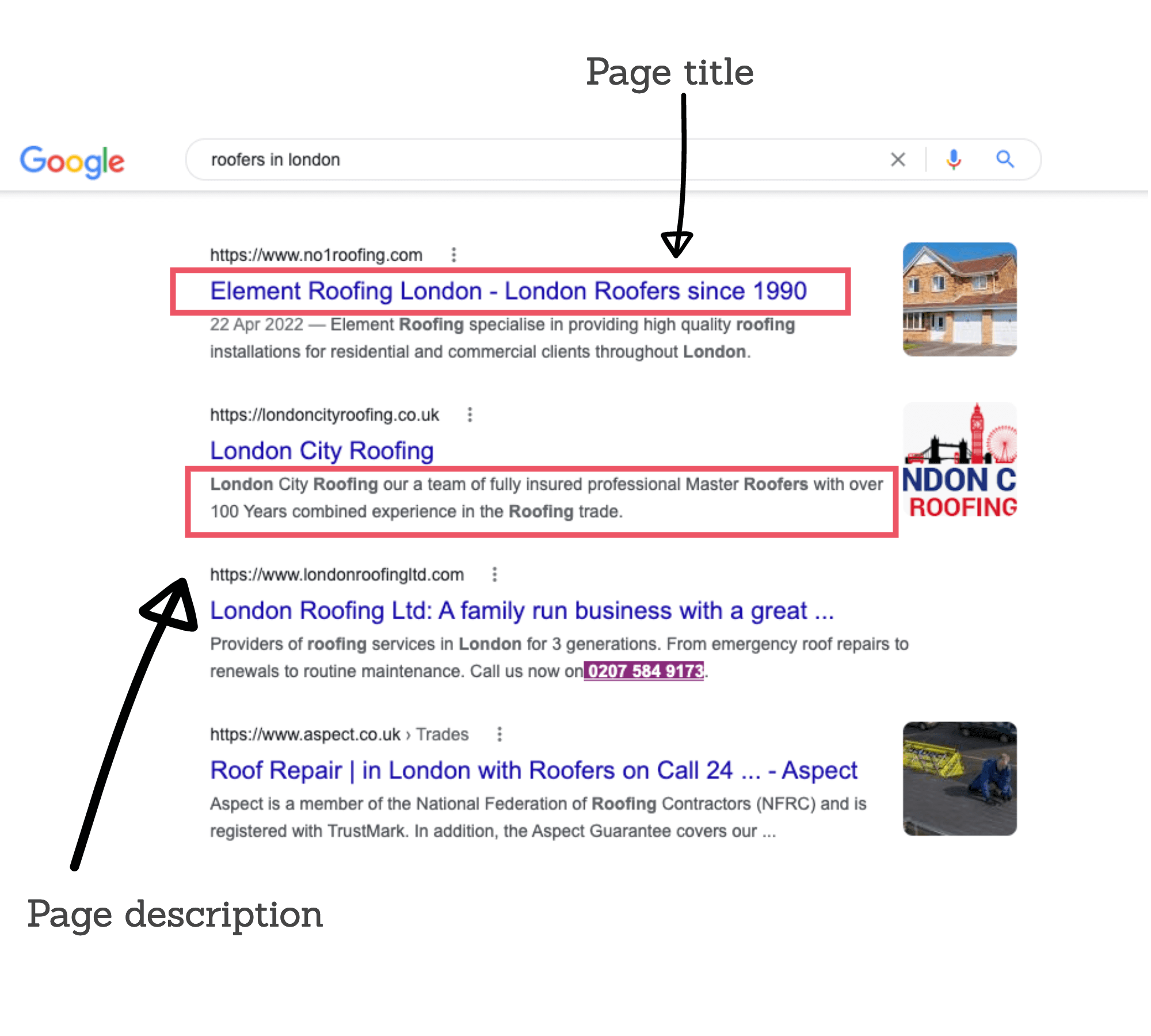
When you’re writing your page titles and descriptions, you should keep the following things in mind:
Use keywords.
Make sure to use your target keywords in your page titles and descriptions.
This will help to improve your SEO and attract more visitors to your website. Also, use the location you would like to target in the page title. This will help the page rank for a local keyword.
Keep it short and sweet.
Your page title should be no more than 60 characters, and your page description should be no more than 155. In case you are struggling to keep the following character limit, consider utilizing an AI driven summarizing tool.
Make it unique.
A mistake we always see is roofing websites with the same title and description on every page.
Each of your pages should have a unique page title and description. No two pages should be the same. Having all the duplicate page titles and descriptions on every page is bad for SEO, and Google will not rank your website.
Use enticing language in your descriptions.
Your page titles and descriptions should be written to entice people to click on your website. Include the USP of your business or benefits they will get by using your services. People are going to see this description on the first page of Google, so give them a reason to click through.
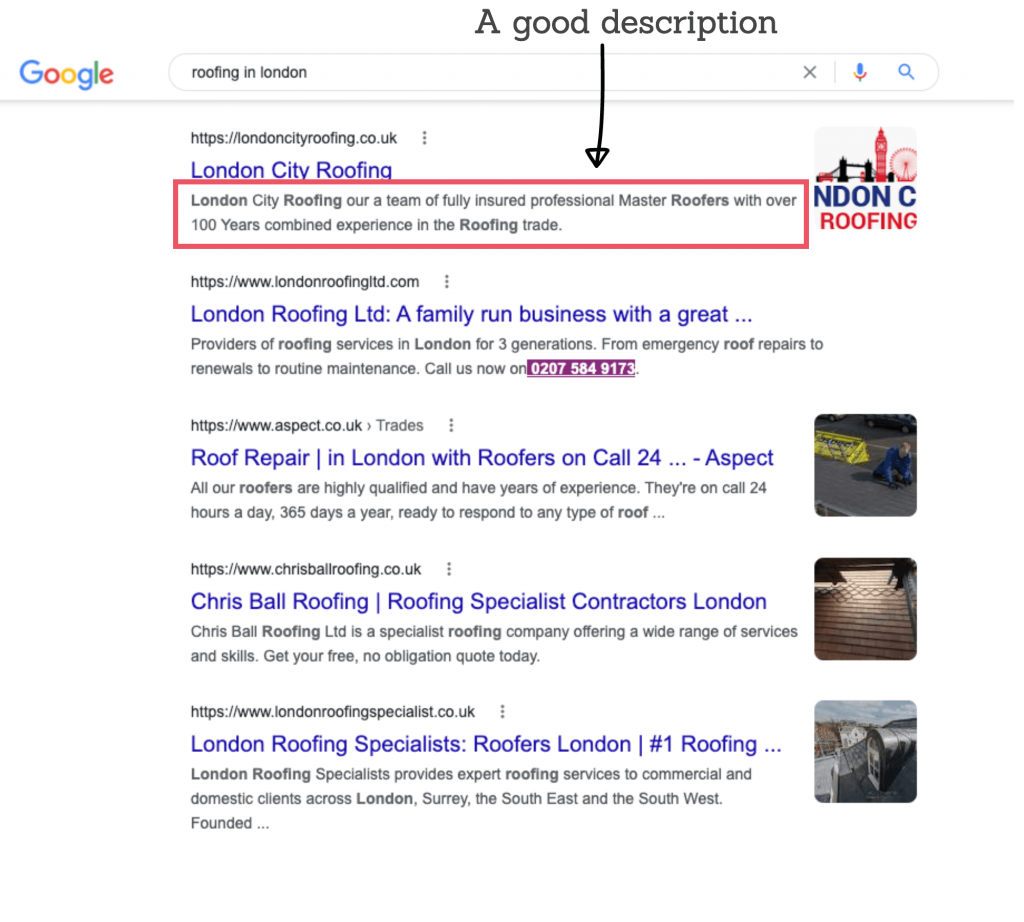
Why is this description good?
- It says master roofers fully insure the company
- The business has over 100 years of combined experience
- Three generations of roofers 24-hour roofing seven days a week
- Get a free no-obligation quote today
You can use some of these USPs on your descriptions to pull potential customers into your website.
12. Why you should build a roofing blog
If you’re not already doing so, you should consider starting a roofing blog. A blog is a great way to learn digital marketing and share your expertise with the world and attract new customers to your business.
Here are a few reasons why you should start a roofing blog:
It helps you to attract new customers
If you can provide helpful and informative articles on your blog, then this will help to attract new customers to your business. When people see that you know what you’re talking about, they will be more likely to use your services.
It helps you to build trust and credibility
You can build trust and credibility with your readers by writing helpful and informative articles.
This is important because people are more likely to use a roofing company that they trust and feel confident in.
It helps you to stay up-to-date with the latest industry news
If you want to stay up-to-date with the latest roofing industry news, starting a blog is a great way to do it. By writing about the latest trends and developments, you can ensure that your customers always have the most up-to-date information.
It gives you a chance to show off your work
If you have some impressive projects that you’ve completed, then a blog is a great way to show them off. You can write articles about the projects and include photos and videos to show them off.
It’s a great way to connect with your customers
A blog is an excellent startup platform for connecting with your customers. You can interact with them in the comments section and answer any questions they may have.
This will help to build a strong relationship between you and your customers.
Here is an example of a great roofing blog post.
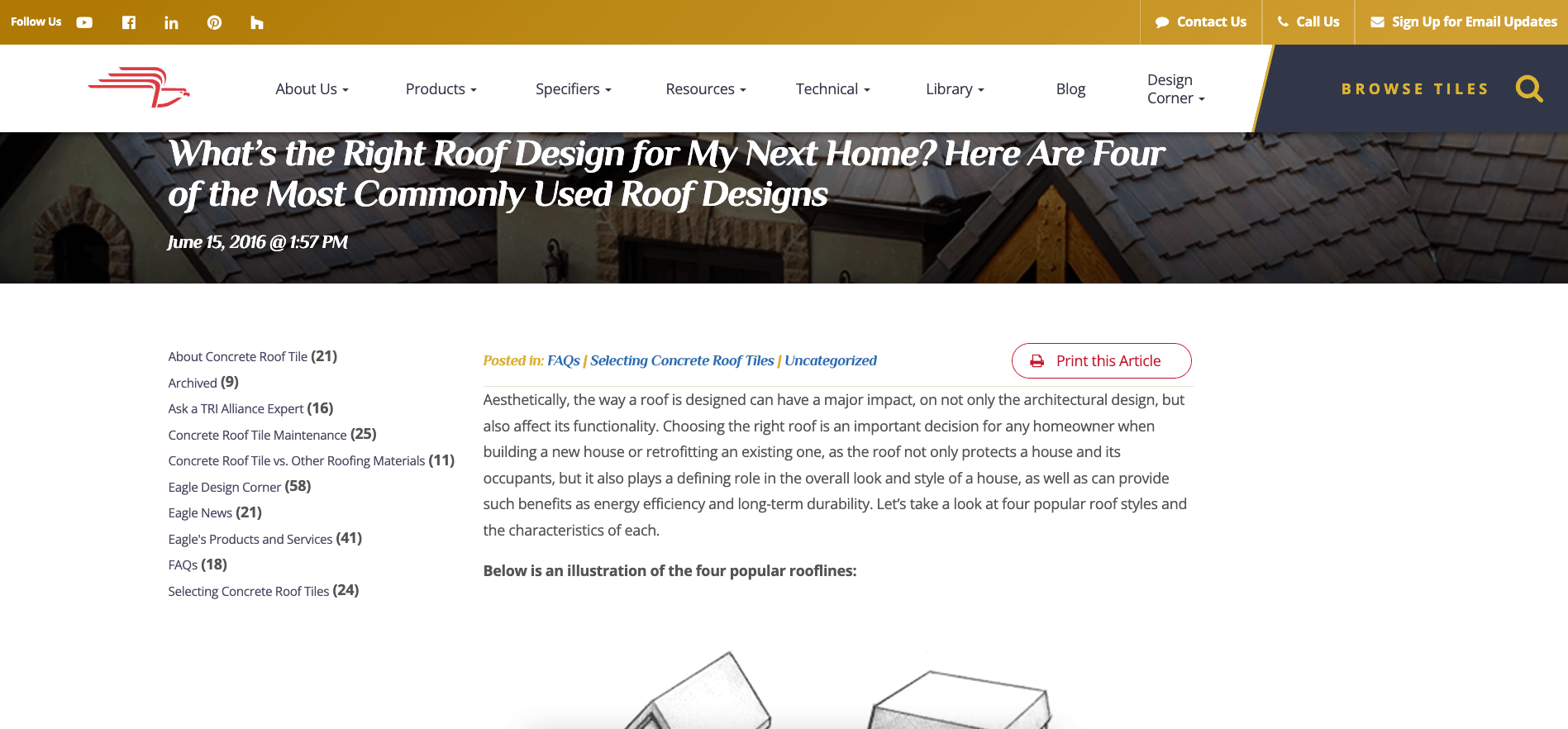
This is a great blog post because it provides helpful and informative content without being salesy. It also includes photos to explain the solution.
This article gets over 1700 clicks a month, so you can see how this is a great way to get your target customer on your website.
If you can provide blog posts similar to this, you will be sure to attract new customers and build trust and credibility with your existing ones.
11. Alt tagging images
If you have any images on your website, it’s important to ensure they all have alt tags. Alt tags are a code that helps Google understand what an image is about.
This is important because it helps Google to index your images and show them in the search results. It also allows people with disabilities to understand what an image is about.
If you don’t already have alt tags on your images and your website is built on WordPress, you can easily add them using a plugin like Yoast SEO.
Simply install the plugin and then go to the “Media” section. From there, you can add alt tags to all of your images.
Use keywords in your alt tags so that Google can understand the image. For example, if you have an image of a roof, your alt tag could be like “roofing company”.
10. How long does roofing SEO take
There is no definitive answer to this question because it depends on several factors.
The main factor affecting how long roofing SEO takes is the competition for the keywords you’re targeting.
If there are already a lot of roofing companies ranking for the keywords you want to target, then it will take longer to rank.
Another factor that will affect how long roofing SEO takes is your website. If your website is poorly made and lacks much content, it will take longer to rank.
If you’re just starting out with roofing SEO, it’s best to set realistic expectations. It can take several months to start seeing results, so don’t get discouraged if you don’t see results immediately.
The best way to rank faster is by having a plan and then building everything quickly, getting all of your pages ready, adding all of the content and then indexing the whole site. After that, the optimisation process is just monitoring keywords and building backlinks. Crafting a speedy path to higher rankings involves a strategic approach. Employing a daily planner app becomes your secret weapon in efficiently planning and executing the steps.
9. Your URL structure
Your URL structure is vital for two reasons. First, it helps Google to understand what your website is about. Second, it lets people know what they’re going to get when they click on a link.
If you have a roofing website, you should have a URL structure that reflects that. For example, your home page could be www.roofingexample.com, and then you could have other pages like www.roofingexample.com/roofing/services or www.roofingexample.com/roofing/projects

8. Optimise your Google My Business listing

Google My Business is a free listing that allows businesses to control how they appear on Google Maps and in the local search results.
You need first to claim your listing to optimise your Google My Business listing. To do this, go to www.google.com/business and then click on “Get started”
Enter your business name and address into the form and then click on “Search”. If your business is already listed, you must click on “Claim this business”.
If your business is not listed, you will need to click on “Add your business”.
Once you’ve claimed your listing, you can start optimising it. The first thing you need to do is to add some photos.
Google My Business allows you to add up to 10 photos of your business. These can be exterior photos, interior photos, or even team photos. The more pictures you add, the better.
The next thing you need to do is to add a description of your business. This should be a short paragraph that tells people what your company does and what sets you apart from your competitors.
After that, you need to add your business hours. Google My Business will allow you to set different hours for different weekdays. You can also set special hours for holidays.
The next thing you need to do is to add your contact information. This includes your website URL, your phone number, and your email address.
Finally, you need to add some categories. These are the types of products or services that you offer.
You can add up to 5 categories. For example, if you’re a roofing company, then you might add “roofing”, “roof repair”, “roof replacement”, “solar panel installation”, and “siding”.
Once you’ve added all of this information, your Google My Business listing should be optimised for local SEO.
If you want to take things a step further, you can add additional information such as service areas, pricing, and appointment scheduling.
Adding this extra information will make it easier for people to find your business and contact you.
7. Optimise your website for mobile

More and more people are using their phones to search the internet. Google now processes more than 60% of all mobile searches.
This means that if your website is not optimised for mobile, you’re missing out on many potential traffic and customers.
To optimise your website for mobile, the first thing you need to do is to make sure that your website is responsive.
A responsive website is one that automatically adjusts to fit any screen size. This is important because you want people to view your website on their phones easily.
Use this free tool by Google to test if your website is mobile-friendly [Click here]
6. USP's & CTA's
Your unique selling proposition (USP) sets your business apart from your competitors. It’s what makes you unique.
For example, let’s say you’re a roofing company. Your USP could be that you offer the quickest roof repairs in town, use the best quality materials and your work is fully insured for a year.
Whatever it is, make sure that your USP is prominently featured on your website, its better than your competitors and in all your marketing materials.
And don’t forget to include a call-to-action (CTA). A CTA is a statement or button that tells people what you want them to do.
For example, your CTA could be “Call us now for a free quote!” or “Click here to book a free roof survey!”
Make sure that your CTA is clear and concise. And make sure that it’s prominently featured on your website and in your marketing materials.
By following these tips, you can optimise your website for local SEO and attract more customers to your roofing business.
Your unique selling proposition (USP) sets your business apart from your competitors. It’s what makes you unique.
For example, let’s say you’re a roofing company. Your USP could be that you offer the quickest roof repairs in town, use the best quality materials and your work is fully insured for a year.
Whatever it is, make sure that your USP is prominently featured on your website, its better than your competitors and in all your marketing materials.
And don’t forget to include a call-to-action (CTA). A CTA is a statement or button that tells people what you want them to do.
For example, your CTA could be “Call us now for a free quote!” or “Click here to book a free roof survey!”
Make sure that your CTA is clear and concise. And make sure that it’s prominently featured on your website and in your marketing materials.
By following these tips, you can optimise your website for local SEO and attract more customers to your roofing business.
5. Internally linking your pages

Another important factor in local SEO is internal linking. This is when you link to other pages on your website from within your website.
For example, let’s say you have a page on your website about roof repairs. You could internally link to that page from your home page, your “about us” page, and your “services” page.
Internal linking is crucial because it helps Google understand your website. It also helps to increase the amount of time people spend on your website, which is a ranking factor for Google.
To do this, simply add links to other pages on your website whenever it’s relevant. For example, if you’re writing a blog post about roofing, you could add a link to your “new roof installation page” page.
Here is a perfect example of doing this on this post you are on right now. Let’s say we want to include a link for “get more roofing leads” we can link to a relevant page on the website.
This passes link authority around the website, and Google will know which pages to rank for relevant keywords.
Ensure that the anchor text (the text you’re linking) is relevant to the page you’re linking to. For example, if you’re relating to your “roof repair”, then the anchor text could be “roof repair”, “repair your roof”, or “fix your roof”.
Do not keyword stuff your anchor text. These means don’t just fill your anchor text with keywords such as “roofer”, “roofing company”, and “roofing contractor”. This will look spammy, and it will hurt your SEO.
4. Share all your new content on websites like Quora and Reddit
Content is still king when it comes to SEO. Google loves new content, and they will reward you with higher rankings if you regularly publish fresh and relevant content.
One of the best ways to get your content seen by Google is to share it on popular websites like Quora and Reddit.
When you share your content on these websites, ensure you include a link to your website. This will help Google find your content and index it in their search results.
An example of this is this Quora page [how do you find a roofing contractor?] This will be a great place to post relevant content, help out the readers and link back to your pages.
3. Use Schema on your website pages
Schema is a code that you can add to your website pages to give Google more information about your business.
Adding schema to your website pages helps Google understand your business and its location. This can help you rank higher in Google’s local search results.
To learn more about schema and how to add it to your website, check out this article from Search Engine Land [click here].
2. Page speed optimisation
There are a few things you can do to improve your page speed:
- Use a fast web host
- Optimise your images
- Minimise HTTP requests
- Use a content delivery network (CDN)
- Enable browser caching
- Minify your HTML, CSS, and JavaScript files
- Avoid using too many plugins
- Use a faster WordPress theme
1. Track keyword performance
Once you’ve implemented all of the tips in this guide, it’s time to start tracking your keyword performance.
The best way to do this is with tools like SEMRush free trail and Google Search Console.
Go to google search console and ..
- Click on the full report
- Here you will see Queries, Pages, Countries, Devices, Search Appearance & dates
- Click on queries
This will show you all of the keywords your website is ranking for - Sort them by impression or clicks
- You can also use the filter option to search by keyword position.
This gives you invaluable data to optimise your website.
Another great way of doing this is by using SEMRush, putting in a list of keywords you would like to track, and this software will keep track of the positions and alert you when they drop or improve. SEMRush is one of our favourite SEO Tools to use.
Write for humans first and search engines second.
When writing content for your website, it’s important to remember that you’re writing for humans first and search engines second.
This means that your content should be well-written, informative and engaging. It should be keyword-rich but not spammy so that it can be easily found by people searching for information on your topic.
Spamming loads of keywords on the pages will not only put off your readers but Google will eventually notice this, and your website will drop in the search results.
Summary
We hope this article was helpful, and you are now a roofing SEO pro!
If you need help improving your roofing website SEO, please contact us, and we’ll be happy to help. Our team of experienced SEO specialists can help to improve your website’s ranking in the search engines and drive more traffic to your site. Contact us today for a free consultation.

Speak to an expert
Got a quick question about your marketing? Or you want to run through the details of your next big project. We can help.
Speak to one of our experts today on 01702 668207 or send us a message.
